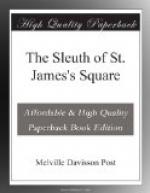I was going on quickly, when Marquis stopped. He was stooping over the track of the vehicle. He did not come on and I went back.
“What is it?” I said.
He answered, still stooping above the track.
“The cut-under stopped here.”
“How do you know that?” I asked, for it seemed hardly possible to determine where a wheeled vehicle had stopped.
“It’s quite clear,” he replied. “The horse has moved about without going on.”
I now saw it. The hoof-marks of the horse had displaced the dust where it had several times changed position.
“And that’s not all,” Marquis continued. “Something has happened to the cut-under here!”
I was now closely beside him.
“It was broken down, perhaps, or some accident to the harness?”
“No,” he replied. “The wheel tracks are here broadened, as though they had skidded on a turn. This would mean little if the cut-under had been moving at the time. But it was not moving; the horse was standing. The cut-under had stopped.”
He went on as though in a reflection to himself.
“The vehicle must have been violently thrown about here, by something.”
I had a sudden inspiration.
“I see it!” I cried. “The horse took fright, stopped, and then bolted; there has been a run-away. That accounts for the turn out. Let’s hurry!”
But Marquis detained me with a firm hand on my arm.
“No,” he said, “the horse was not running when it turned out and it did not stop here in fright. The horse was entirely quiet here. The hoof marks would show any alarm in the animal, and, moreover, if it had stopped in fright there would have been an inevitable recoil which would have thrown the wheels of the vehicle backward out of their track. No moving animal, man included, stopped by fright fails to register this recoil. We always look for it in evidences of violent assault. Footprints invariably show it, and one learns thereby, unerringly, the direction of the attack.”
He rose, his hand still extended and upon my arm.
“There is only one possible explanation,” he added. “Something happened in the cut-under to throw it violently about in the road, and it happened with the horse undisturbed and the vehicle standing still. The wheel tracks are widened only at one point, showing a transverse but no lateral movement of the vehicle.”
“A struggle?” I cried. “Major Carrington was right, Madame Barras has been attacked by the driver!”
Marquis’ hand held me firmly in the excitement of that realization. He was entirely composed. There was even a drawl in his voice as he answered me.
“Major Carrington, whoever he may be,” he said, “is wrong; if we exclude a third party, it was Madame Barras who attacked the driver.”
His fingers tightened under my obvious protest.
“It is quite certain,” he continued. “Taking the position of the standing horse, it will be the front wheels of the cut-under that have made, this widened track; the wheels under the driver’s seat, and not the wheels under the guest seat, in the rear of the vehicle. There has been a violent struggle in this cut-under, but it was a struggle that took place wholly in the front of the vehicle.”




